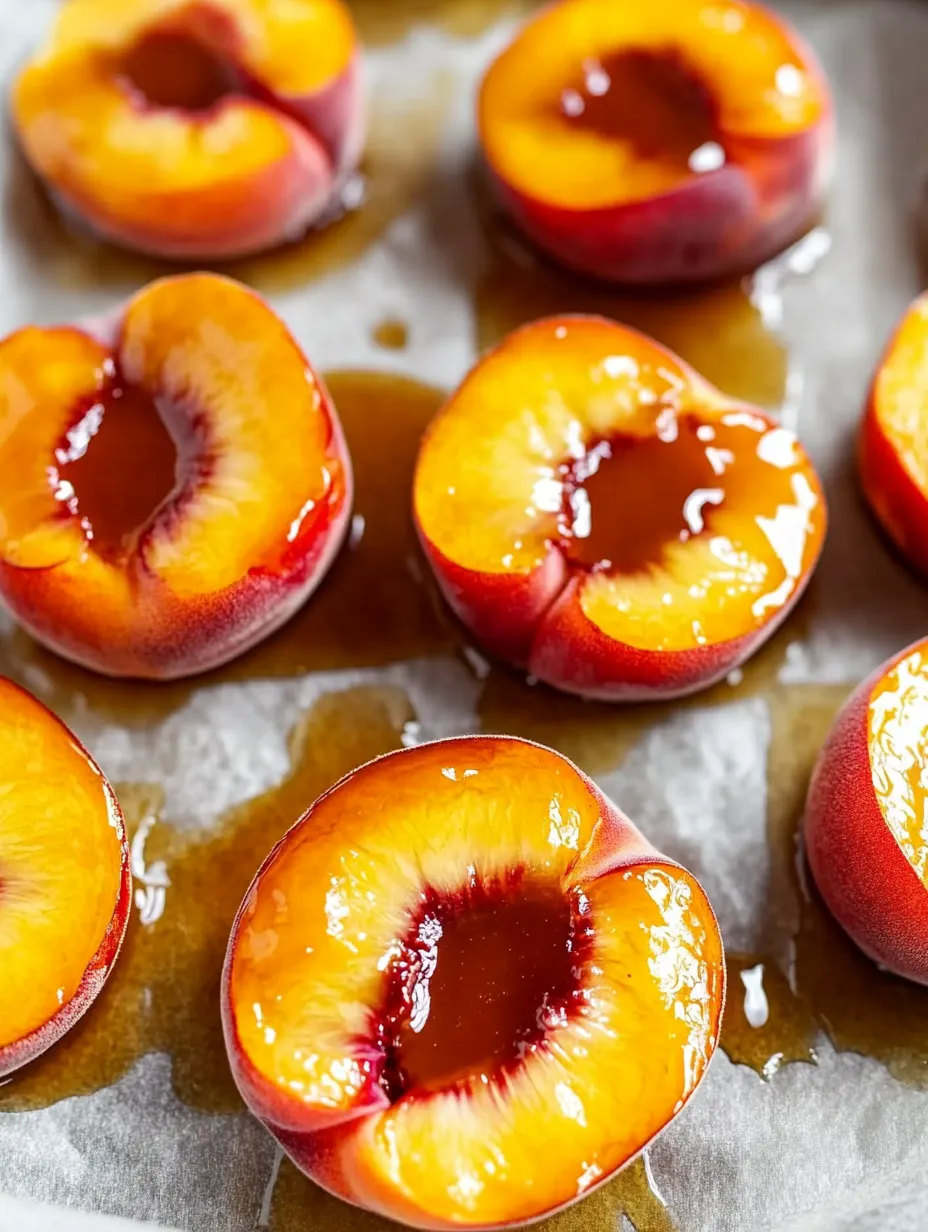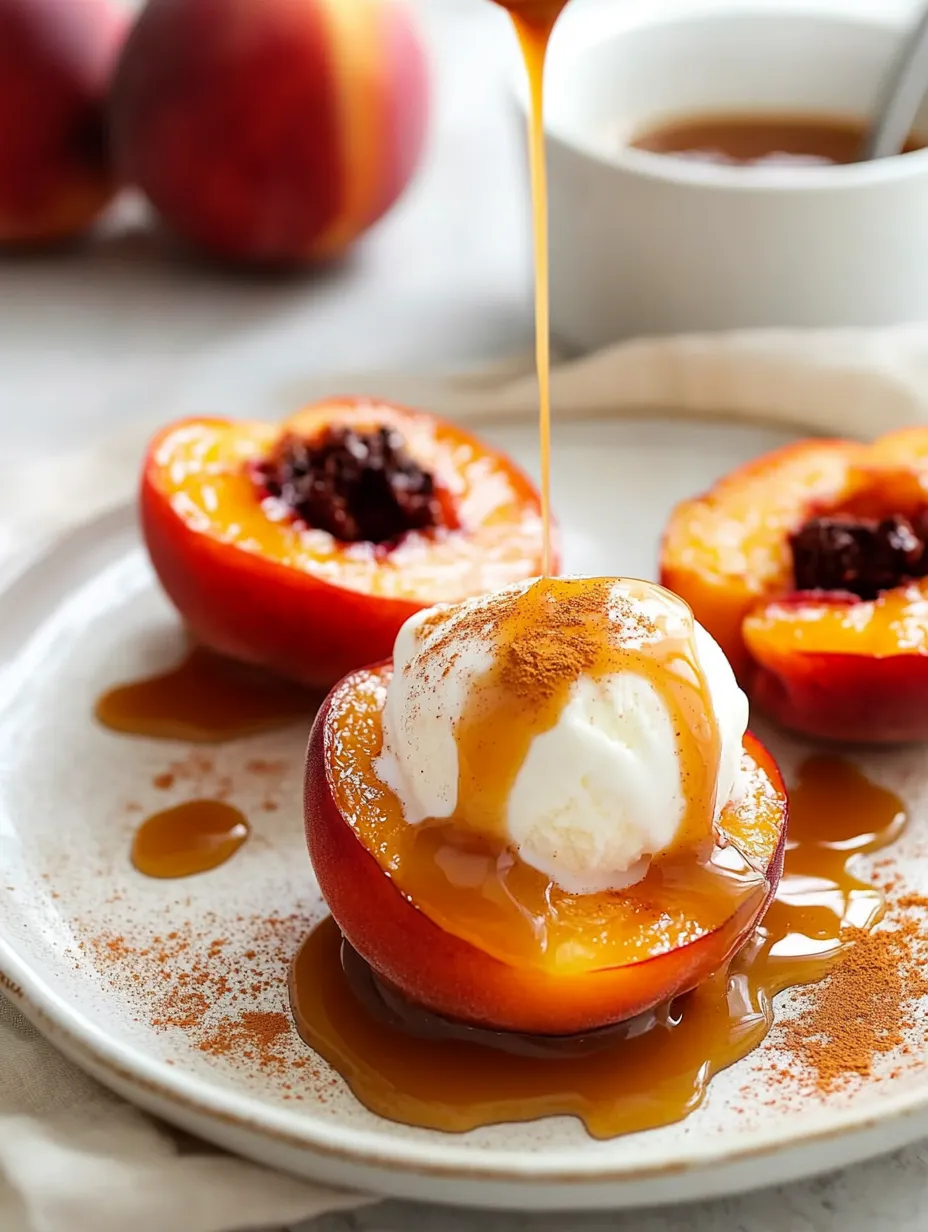 Pin it
Pin it
Warm Stone Fruit Magic
This sublime summer dessert transforms simple nectarines into a warm, fragrant indulgence through gentle baking that intensifies their natural sweetness. The magic happens when heat caramelizes the fruit's natural sugars while the honey cinnamon sauce creates a rich glaze that elevates the humble nectarine to dessert status. I discovered this recipe during a particularly abundant stone fruit season when looking for alternatives to the usual pies and cobblers.
Summer Simplicity
I first prepared these baked nectarines for an impromptu dinner with friends when time was short but I wanted to serve a proper dessert. The stunned silence followed by exclamations of delight confirmed this would become a signature summer recipe. Even my father, who typically passes on dessert entirely, requested seconds and asked for the recipe to take home. What began as a simple solution has become my most requested summer dessert, especially after guests realize how incredibly simple it is to prepare.
Perfect Components
- Ripe Nectarines (3 medium): Provide the essential foundation with their sweet flesh, slight tanginess, and beautiful color that intensifies during baking
- Pure Honey (1/4 cup): Creates the base for the glaze while contributing floral notes and natural sweetness that complements the fruit perfectly
- Ground Cinnamon (1/2 teaspoon): Adds warm, aromatic depth that enhances the fruit's natural sweetness while creating that familiar baked dessert fragrance
- Vanilla Extract (1/2 teaspoon): Introduces subtle complexity and rounds out the sauce flavors while bridging the fruit and spice elements
- Vanilla Ice Cream: Offers the perfect creamy contrast to the warm fruit, melting slightly to create a luscious sauce with the honey glaze
 Pin it
Pin it
Effortless Technique
- Sauce Creation:
- Begin by preparing the simple yet transformative cinnamon honey sauce. In a small bowl, combine 1/4 cup of good quality honey with 1/2 teaspoon each of ground cinnamon and pure vanilla extract. The honey should be in liquid form for proper mixing, so if it has crystallized, warm it gently by placing the container in a bowl of warm water for a few minutes before measuring. Whisk these ingredients together thoroughly until the cinnamon is completely incorporated with no visible specks remaining. This thorough mixing ensures even distribution of flavor throughout the sauce. The mixture will appear glossy and somewhat thin at room temperature but will thicken beautifully as it heats in the oven. Set this sauce aside while preparing the fruit.
- Fruit Preparation:
- Preheat your oven to 350°F to ensure it reaches the proper temperature before the nectarines go in. Select a baking dish that will hold all six nectarine halves comfortably without crowding, as they need space for the sauce to surround them. A 9x9 inch square dish or equivalent oval baker works perfectly. Lightly coat the dish with cooking spray to prevent sticking, which helps preserve the beautiful appearance of the fruit when serving. Wash the nectarines thoroughly, then slice them in half along their natural seam, twisting gently to separate the halves. Remove the pits carefully, using a small spoon to help pry them out if necessary without damaging the fruit. If any halves have deep cavities where the pits were removed, you can gently widen them with a small spoon, creating perfect little wells to hold extra sauce.
- Assembly Approach:
- Arrange the prepared nectarine halves in your baking dish with the cut sides facing upward, positioning them so they sit flat and stable. The cavity where the pit was should form a natural depression to hold the sauce. If some halves wobble, make small, flat cuts on the bottom to create a stable base without sacrificing too much fruit. Give the honey cinnamon sauce a final whisk, then spoon it generously over each nectarine half, allowing it to fill the cavity and spill over slightly onto the cut surface. Don't worry if some sauce pools in the bottom of the dish, as this will create a delicious syrup during baking that you'll use for the final presentation. Reserve approximately one tablespoon of the sauce for drizzling after baking if desired.
- Baking Perfection:
- Place the baking dish on the center rack of your preheated oven and bake for 25 to 30 minutes. The exact timing will depend on the ripeness of your nectarines and your preference for texture. Perfectly baked nectarines should be tender enough to easily pierce with a fork, but still maintain their shape rather than collapsing completely. The sauce should be bubbling gently around the edges and have transformed into a thicker, more caramelized consistency. The fruit will have deepened in color and might have slightly wrinkled skin, which indicates proper caramelization of the natural sugars. Remove from the oven and allow to cool for approximately 5 minutes before serving, which allows the bubbling sauce to settle slightly while still serving the dessert warm.
I particularly appreciate how this dessert celebrates summer's bounty without masking the natural fruit flavor. Growing up, my grandmother always insisted that the simplest preparations often showcase exceptional ingredients best. This philosophy shines through in this recipe, where quality nectarines take center stage rather than being buried under excessive sugar or complicated techniques. When serving this to guests for the first time, I enjoy watching their surprise at how something so simple can taste so extraordinary. During one summer gathering, my neighbor's child asked if we could pick more nectarines specifically to make this dessert again the following day.
Serving Excellence
This versatile dessert welcomes numerous serving approaches depending on the occasion and personal preferences. For casual family desserts, spoon warm nectarine halves into shallow bowls, top with a generous scoop of vanilla ice cream, and drizzle with the warm sauce from the baking dish. When entertaining, create more elegant presentations by placing each nectarine half on individual dessert plates with a small scoop of ice cream nestled alongside rather than on top, then drizzle the plate with sauce in an artistic pattern. For brunch gatherings, consider serving over Greek yogurt with a sprinkle of granola instead of ice cream for a more breakfast appropriate option. Those watching calories might enjoy these nectarines with just a small dollop of freshly whipped cream or even on their own, as the honey cinnamon sauce creates sufficient richness without additional toppings.
Flavor Adventures
This foundation recipe welcomes numerous adaptations based on preference or seasonal availability. For deeper flavor complexity, add a pinch of cardamom or ginger to the honey sauce, creating subtle warmth that complements the cinnamon beautifully. Stone fruit versatility allows substituting perfectly ripe peaches, plums, or apricots using identical preparation methods. Those enjoying adult desserts might add a tablespoon of bourbon or dark rum to the sauce before baking for sophisticated flavor notes. In autumn, pears make an excellent substitute for nectarines, perhaps with a sprinkle of nutmeg added to the sauce. For additional texture, sprinkle chopped toasted almonds, pecans, or walnuts over the ice cream just before serving. Citrus enthusiasts might appreciate adding a teaspoon of orange or lemon zest to the honey mixture, brightening the flavor profile while maintaining the dessert's essential simplicity.
 Pin it
Pin it
Storage Solutions
While this dessert reaches its absolute peak when served immediately after baking, leftovers can be properly stored and enjoyed later. Allow any remaining nectarines to cool completely before transferring to an airtight container and refrigerating for up to three days. Reheat individual portions in the microwave for 20 to 30 seconds until just warm before topping with fresh ice cream. The honey cinnamon sauce keeps beautifully when stored separately in a small jar or container in the refrigerator for up to two weeks, thickening when cold but returning to pourable consistency when gently warmed. This makes it worthwhile to prepare a double batch of sauce, using the remainder to drizzle over morning oatmeal, yogurt parfaits, or even as a unique addition to cheese boards where the sweet spiced honey pairs beautifully with sharp cheeses and crisp fruit slices.
After preparing this dessert countless times through summer seasons, I've come to appreciate it not just for its delicious results but for the cooking philosophy it represents. In a world of complicated recipes and extensive ingredient lists, there's something genuinely refreshing about a dessert that celebrates simplicity and quality over complexity. The transformation that occurs when heat, honey, and cinnamon meet perfect summer fruit creates something far greater than the sum of its parts. While elaborate desserts certainly have their place, this humble preparation reminds us that sometimes the most memorable food experiences come from letting exceptional ingredients shine through thoughtful but minimal preparation.
Frequently Asked Questions
- → How do I know when nectarines are ripe enough for this recipe?
- The best nectarines for baking should be ripe but still firm. They should yield slightly to gentle pressure but not be mushy. A ripe nectarine will have a sweet, fruity fragrance at the stem end. If your nectarines are too firm, leave them at room temperature for 1-2 days to ripen. Slightly underripe nectarines will still work in this recipe as the baking process softens them, but they may require a bit more baking time and might not release as much juice.
- → Can I make this recipe with other fruits?
- Absolutely! This recipe works beautifully with peaches, plums, apricots, or even pears (though pears may need less baking time depending on ripeness). For smaller fruits like apricots or plums, you may want to adjust the amount of honey sauce slightly. You can also try a mixed fruit version with different stone fruits for varied flavors and colors. The key is choosing fruits that hold their shape when baked but become tender and juicy.
- → Is there a way to make this recipe dairy-free or vegan?
- Yes, this recipe is easily adaptable for dietary restrictions. The fruit and honey sauce components are naturally dairy-free. To make it completely vegan, simply substitute the honey with maple syrup or agave nectar in equal amounts. For serving, top with your favorite dairy-free ice cream or coconut whipped cream. The flavor profile will be slightly different but equally delicious.
- → Can I prepare these baked nectarines in advance?
- You can prepare these nectarines partially in advance. Halve and pit the nectarines and mix the sauce up to a day before. Store them separately in the refrigerator. When ready to serve, arrange the nectarines in your baking dish, pour over the sauce (you may need to warm the sauce slightly if the honey has crystallized), and bake as directed. For the best experience, these are ideally served warm from the oven with cold ice cream, but they can also be reheated gently in a 300°F oven for about 10 minutes.
- → What can I add to enhance this recipe for a special occasion?
- For a more indulgent or festive version, try these additions: Sprinkle chopped nuts (like walnuts, almonds, or pecans) over the nectarines before baking for added texture and flavor. Add a splash of liqueur (such as amaretto, brandy, or bourbon) to the honey sauce for a sophisticated twist. Incorporate warm spices like nutmeg, cardamom, or ginger along with the cinnamon. For serving, drizzle with a reduction of balsamic vinegar or sprinkle with fresh herbs like basil or mint for a unique flavor contrast.
- → What's the best way to remove the pit from nectarines?
- To easily pit nectarines: Cut around the circumference of the fruit, following the natural seam. Twist the halves in opposite directions to separate them. For freestone varieties, the pit will come out easily. For clingstone varieties (where the pit adheres to the flesh), use a small spoon or melon baller to carefully scoop around the pit to remove it. If you encounter a stubborn pit, you can carefully cut the nectarine into quarters around the pit, then separate each quarter from the pit.
